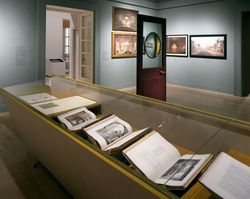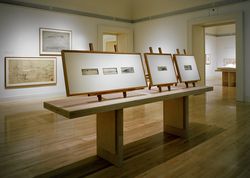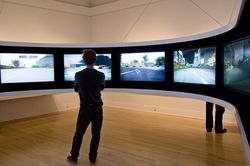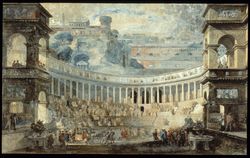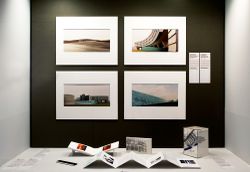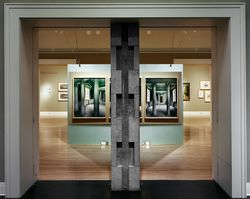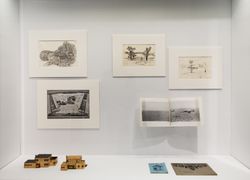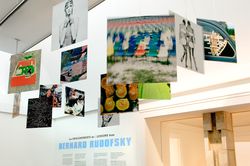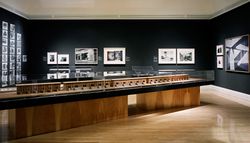John Soane 1753-1837
Described by Henry James as “one of the most curious things in London,” Sir John Soane’s Museum was built as the picturesque and enigmatic home, office, collector’s trove, and personal showplace of one of history’s most innovative architects. This exhibition is a major re-evaluation of Soane’s career, as well as a reconsideration of his importance to the history of modern(...)
Main galleries
16 May 2001 to 3 September 2001
John Soane 1753-1837
Actions:
Description:
Described by Henry James as “one of the most curious things in London,” Sir John Soane’s Museum was built as the picturesque and enigmatic home, office, collector’s trove, and personal showplace of one of history’s most innovative architects. This exhibition is a major re-evaluation of Soane’s career, as well as a reconsideration of his importance to the history of modern(...)
Main galleries
A revolutionary approach to the relationship between building and landscape, which shaped them together according to peculiarly American ideals, is the subject of Frank Lloyd Wright: Designs for an American Landscape, 1922–1932. In this exhibition, the CCA reconstructs five unbuilt, visionary projects that imagined nothing less than a new American landscape, integrating(...)
Main galleries
18 June 1996 to 29 September 1996
Frank Lloyd Wright: Designs for an American Landscape, 1922-1932
Actions:
Description:
A revolutionary approach to the relationship between building and landscape, which shaped them together according to peculiarly American ideals, is the subject of Frank Lloyd Wright: Designs for an American Landscape, 1922–1932. In this exhibition, the CCA reconstructs five unbuilt, visionary projects that imagined nothing less than a new American landscape, integrating(...)
Main galleries
Speed Limits
Speed Limits addresses the pivotal role played by speed in modern life: from art to architecture and urbanism to graphics and design to economics to the material culture of the eras of industry and information. It marks the centenary of the foundation of the Italian Futurist movement, whose inaugural manifesto famously proclaimed “that the world’s magnificence has been(...)
Main galleries
20 May 2009 to 8 November 2009
Speed Limits
Actions:
Description:
Speed Limits addresses the pivotal role played by speed in modern life: from art to architecture and urbanism to graphics and design to economics to the material culture of the eras of industry and information. It marks the centenary of the foundation of the Italian Futurist movement, whose inaugural manifesto famously proclaimed “that the world’s magnificence has been(...)
Main galleries
During the eighteenth century, Rome was both an important centre for Italian art and the focal point for the studies of most European artists; all were drawn by the city’s antique art, architecture, and statuary, as well as its Renaissance, Baroque, and eighteenth-century masterpieces. Exploring Rome: Piranesi and His Contemporaries is concerned with eighteenth-century(...)
Main galleries
18 August 1993 to 2 January 1994
Exploring Rome: Piranesi and His Contemporaries
Actions:
Description:
During the eighteenth century, Rome was both an important centre for Italian art and the focal point for the studies of most European artists; all were drawn by the city’s antique art, architecture, and statuary, as well as its Renaissance, Baroque, and eighteenth-century masterpieces. Exploring Rome: Piranesi and His Contemporaries is concerned with eighteenth-century(...)
Main galleries
Arrivals
Arrivals features gifts to the collection received in honour of Phyllis Lambert’s eightieth birthday. It includes original prints by acclaimed photographers and artists experimenting with the language of photography: Dieter Appelt, Robert Burley, Edward Burtynsky, Giovanni Chiaramonte, Thomas Florschuetz, John Gossage, Guido Guidi, Gordon Matta-Clark (donated by Jane(...)
Hall cases
24 January 2008 to 23 March 2008
Arrivals
Actions:
Description:
Arrivals features gifts to the collection received in honour of Phyllis Lambert’s eightieth birthday. It includes original prints by acclaimed photographers and artists experimenting with the language of photography: Dieter Appelt, Robert Burley, Edward Burtynsky, Giovanni Chiaramonte, Thomas Florschuetz, John Gossage, Guido Guidi, Gordon Matta-Clark (donated by Jane(...)
Hall cases
Just as Andrea Palladio’s Villa Rotonda helped to define for future generations the architecture of the Renaissance in Italy, so Chiswick is the locus classicus of the Palladian Revival of the eighteenth century. This exhibition follows a major architect’s thinking as he worked from source to design, from design to representation, in the making of a building which, as the(...)
Main galleries
19 July 1994 to 25 September 1994
The Palladian Revival: Lord Burlington, His Villa and Garden at Chiswick
Actions:
Description:
Just as Andrea Palladio’s Villa Rotonda helped to define for future generations the architecture of the Renaissance in Italy, so Chiswick is the locus classicus of the Palladian Revival of the eighteenth century. This exhibition follows a major architect’s thinking as he worked from source to design, from design to representation, in the making of a building which, as the(...)
Main galleries
Starting From... Travel
Interpreting the subject of travel to distant places, the exhibition charts an expanded notion of travel that spans imaginary journeys, strange sites, vanishing points, floating and portable houses, endless caves, swirling diamond domes, tombs, crypts and catacombs, tunnel adventures, formal studies, technical innovation, cultural imagination, and experimental(...)
Hall cases
3 December 2008 to 1 May 2009
Starting From... Travel
Actions:
Description:
Interpreting the subject of travel to distant places, the exhibition charts an expanded notion of travel that spans imaginary journeys, strange sites, vanishing points, floating and portable houses, endless caves, swirling diamond domes, tombs, crypts and catacombs, tunnel adventures, formal studies, technical innovation, cultural imagination, and experimental(...)
Hall cases
Lessons from Bernard Rudofsky is the first retrospective to examine the life and work of the controversial architect, designer, and critic whose groundbreaking buildings, exhibitions, and fashion designs challenged the Western world’s perceptions of comfort and culture. The exhibition highlights the diverse contributions of a unique and underappreciated pioneer of(...)
Main galleries
4 July 2007 to 30 September 2007
Lessons from Bernard Rudofsky
Actions:
Description:
Lessons from Bernard Rudofsky is the first retrospective to examine the life and work of the controversial architect, designer, and critic whose groundbreaking buildings, exhibitions, and fashion designs challenged the Western world’s perceptions of comfort and culture. The exhibition highlights the diverse contributions of a unique and underappreciated pioneer of(...)
Main galleries
Series
Projets et réalisations
AP066.S2
Description:
Issue de la pratique professionnelle de Jacques Rousseau, cette série regroupe les documents illustrant quatre-vingt-trois projets et réalisations conçus, soit de façon autonome ou en collaboration, entre 1973 et 1997. Ces projets se distinguent autant par leur degré d'achèvement (de l'esquisse préliminaire au dessin de construction), par leur échelle (du mobilier au projet urbain), que par leur programme (commercial, domestique, social). Dans l'ensemble, tous les thèmes qui sont explorés, tels l'architecture du bar, le décor de la boutique, l'habitation individuelle et collective, le lieu de travail, et l'image publique des institutions, s'ancrent dans une pensée spéculative sur la ville comme processus de reconstruction et de refondation. Parmi les quatre-vingt-trois projets, vingt datent d'avant 1980, date à laquelle Jacques Rousseau est devenu membre de l'Ordre des architectes du Québec. Ces projets ont donc été réalisés soit pour le compte d'agences pour lesquelles Jacques Rousseau travaillait ou effectuait son stage professionnel, soit à titre officieux en offrant vraisemblablement ses services à ses connaissances. Dans ce dernier cas, il s'agit alors de projets de plus petite envergure pour des rénovations ou agrandissements de résidences. Par ailleurs, un certain nombre de nouveaux projets n'ont pas abouti et sont constitués seulement de dossiers préliminaires qui nous renseignent toutefois sur les démarches entreprises par l'architecte, parfois de sa propre initiative, pour amorcer des projets. La variété de ces derniers montre les multiples intérêts de Jacques Rousseau. Toutefois, trois d'entre eux émergent de sa pratique : l'architecture de bar et de restaurant, le logement collectif coopératif et la morphologie urbaine pour lesquels il consacre de nombreux projets et études. On trouvera aussi d'ailleurs dans la série 9 - Enseignement des documents relatifs à ses travaux sur la morphologie urbaine.
1973-1997
Projets et réalisations
Actions:
AP066.S2
Description:
Issue de la pratique professionnelle de Jacques Rousseau, cette série regroupe les documents illustrant quatre-vingt-trois projets et réalisations conçus, soit de façon autonome ou en collaboration, entre 1973 et 1997. Ces projets se distinguent autant par leur degré d'achèvement (de l'esquisse préliminaire au dessin de construction), par leur échelle (du mobilier au projet urbain), que par leur programme (commercial, domestique, social). Dans l'ensemble, tous les thèmes qui sont explorés, tels l'architecture du bar, le décor de la boutique, l'habitation individuelle et collective, le lieu de travail, et l'image publique des institutions, s'ancrent dans une pensée spéculative sur la ville comme processus de reconstruction et de refondation. Parmi les quatre-vingt-trois projets, vingt datent d'avant 1980, date à laquelle Jacques Rousseau est devenu membre de l'Ordre des architectes du Québec. Ces projets ont donc été réalisés soit pour le compte d'agences pour lesquelles Jacques Rousseau travaillait ou effectuait son stage professionnel, soit à titre officieux en offrant vraisemblablement ses services à ses connaissances. Dans ce dernier cas, il s'agit alors de projets de plus petite envergure pour des rénovations ou agrandissements de résidences. Par ailleurs, un certain nombre de nouveaux projets n'ont pas abouti et sont constitués seulement de dossiers préliminaires qui nous renseignent toutefois sur les démarches entreprises par l'architecte, parfois de sa propre initiative, pour amorcer des projets. La variété de ces derniers montre les multiples intérêts de Jacques Rousseau. Toutefois, trois d'entre eux émergent de sa pratique : l'architecture de bar et de restaurant, le logement collectif coopératif et la morphologie urbaine pour lesquels il consacre de nombreux projets et études. On trouvera aussi d'ailleurs dans la série 9 - Enseignement des documents relatifs à ses travaux sur la morphologie urbaine.
Series
1973-1997
Marking the 10th anniversary of the CCA’s public opening, the exhibition spotlights and juxtaposes acquisitions from its first decade. Over 350 prints, drawings, photographs, rare books, manuscripts, toys, and models spanning five centuries of architectural history reflect how the built world has been imagined, conceived, and reflected upon. Dedicated to the many donors(...)
Main galleries and hall cases
24 November 1999 to 30 April 2000
En chantier: The Collections of the CCA, 1989-1999
Actions:
Description:
Marking the 10th anniversary of the CCA’s public opening, the exhibition spotlights and juxtaposes acquisitions from its first decade. Over 350 prints, drawings, photographs, rare books, manuscripts, toys, and models spanning five centuries of architectural history reflect how the built world has been imagined, conceived, and reflected upon. Dedicated to the many donors(...)
Main galleries and hall cases
